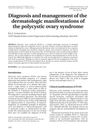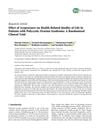TLDR PCOS is common, affects hormones, and often diagnosed late, impacting women's quality of life.
Polycystic ovary syndrome (PCOS) was a prevalent condition affecting 6-12% of women of reproductive age, with an incidence rate of 82.44 per 100,000 in 2017. It involved abnormal hormone levels leading to issues like irregular menstruation, infertility, acne, excessive body weight, and hair loss. Diagnosis often occurred only after complications arose, significantly impacting the quality of life.
514 citations
,
February 2011 in “International journal of women's health” Different treatments for PCOS focus on the specific symptoms, with weight loss and lifestyle changes being important.
 36 citations
,
October 2021 in “Frontiers in Endocrinology”
36 citations
,
October 2021 in “Frontiers in Endocrinology” Insulin resistance and high male hormone levels are major causes of Polycystic Ovary Syndrome.
 97 citations
,
July 2006 in “Dermatologic therapy”
97 citations
,
July 2006 in “Dermatologic therapy” The document concludes that accurate diagnosis and personalized treatment are important for skin problems in women with PCOS.
2 citations
,
September 2021 in “Universal Journal of Pharmaceutical Research” PCOS is linked to hormone disorders and issues like infertility and irregular periods.

Women with Polycystic Ovary Syndrome (PCOS) have a higher risk of developing type 2 diabetes due to insulin resistance.
 October 2023 in “IntechOpen eBooks”
October 2023 in “IntechOpen eBooks” Genes and epigenetic changes are important in the development of Polycystic Ovary Syndrome.
 June 2022 in “Evidence-based complementary and alternative medicine”
June 2022 in “Evidence-based complementary and alternative medicine” Acupressure improves quality of life in PCOS patients.




